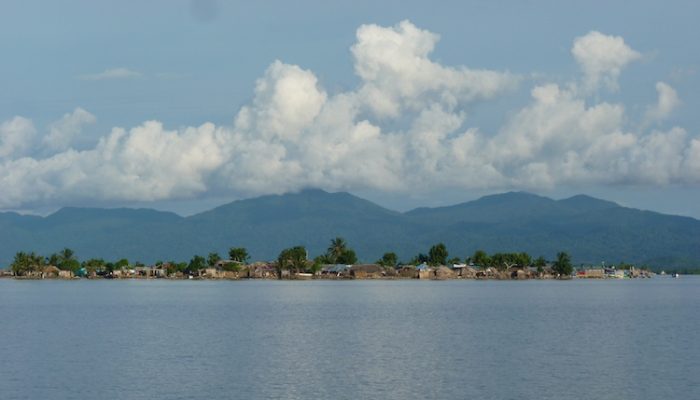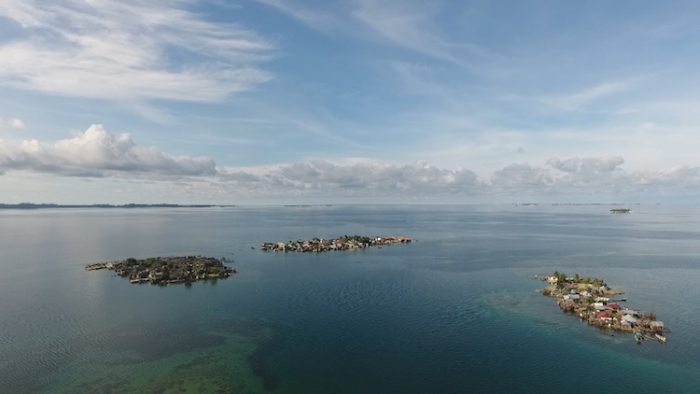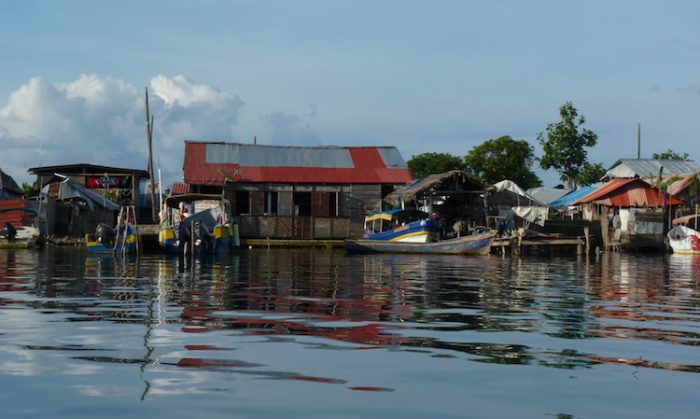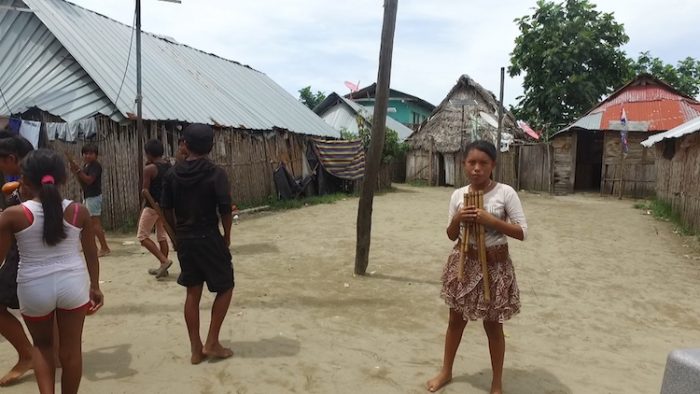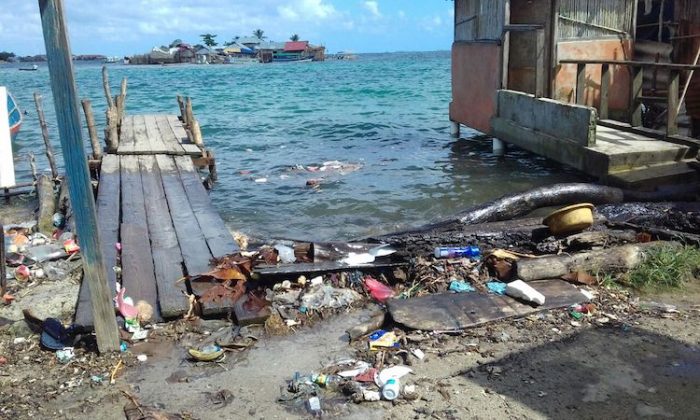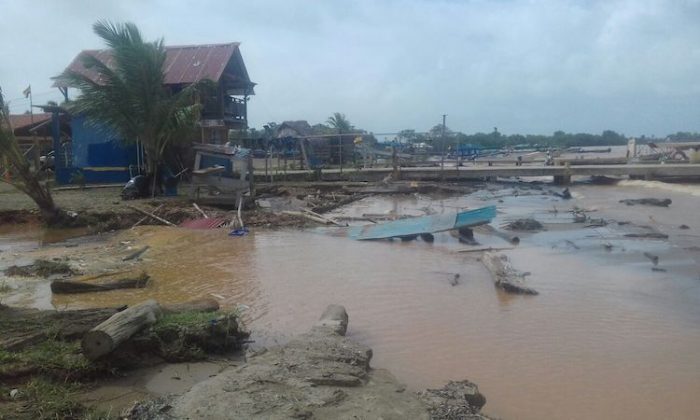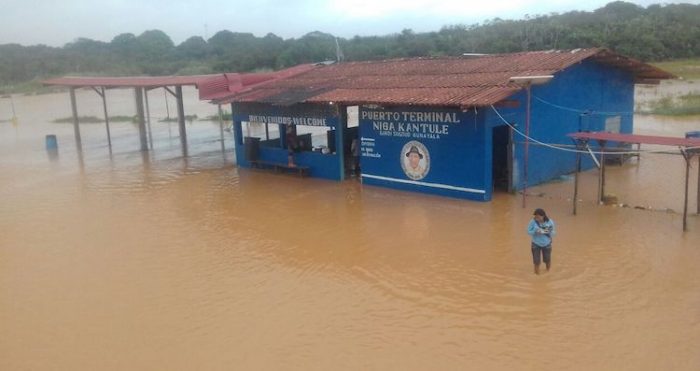By Mary Triny Zea
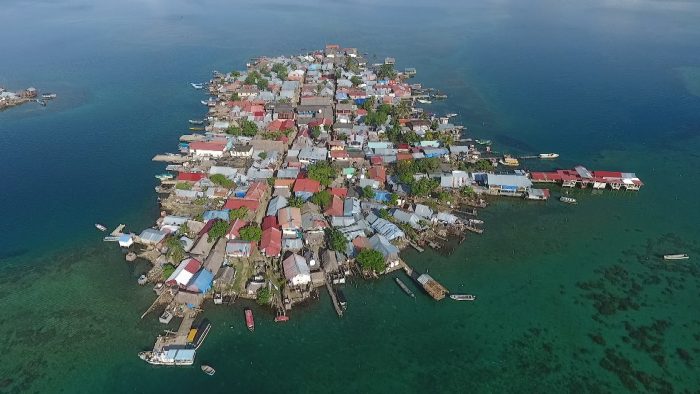

Cartí Sugdup
Spanish version here.
PANAMA — The natives of Cartí Sugdup island, in the archipelago of Guna Yala —known worldwide as San Blas— on the northeast end of the province of Panama, are ready, between fears and hope, to move to the mainland and become the first Latin American indigenous settlement displaced by climate change, according to non-governmental organization Displacement Solutions. In 2017, the Panamanian state resumed its relocation project, which began in 2010.
Some 1,450 Gunas will leave their traditional huts with white sugarcane walls and straw roofs, located on one of the largest islands of the archipelago, to inaugurate, in 2019, some 300, 41-square-meter, two-bedroom homes, with areas for the tribe’s cultural meetings, whose total cost reaches $10 million, according to the government project.
This would unleash the exodus of one of the 36 inhabited islands, of a total of 365 of this indigenous region whose population totals 33,109 inhabitants, distributed among coastal lands and islets.
This move means for many of the “Kunas,” as they were called until 2011, the return to their roots. Historically, they come from the mainland, from the Colombian regions of Urabá, Antioquia and Caldas. Now they are called Gunas because in their alphabet the letter “K” does not exist, a request that emerged from the general congresses of the Bilingual Cultural Education Program.
The accelerated rise in the sea levels, which has already erased some of the islands surrounded by white sand and clear waters that make up this archipelago paradise, coupled with the overcrowding in which they live (because of their beliefs to bring into the world as many children as “God would send them”) forced them to make this decision that still generates debate in 40 other island communities.
A witness to that is a neighbor to the island and mathematics professor, Diomedes Fábrega, who recalls there used to be an island called “Noromulo” that disappeared 10 years ago. He says the increase in temperatures makes his teaching difficult, and that floods in Cartí Sugdup, given the rise in sea levels, used to take place between December and February, but as of five years ago they have been recorded since August.
The Guna culture, their spirituality and traditions, are at stake with the move, warns Dalys Morris, a Guna teacher who belongs to the relocation committee, so they are self-managing the preparations. She says that they have not been guided by the State but that the support has come from international organizations, an opinion shared by islander Vicente González, who maintained that they have no contact with the Panamanian authorities to address the issue of climate change, not even from the Ministry of the Environment, despite the existence of the Climate Change Unit, created in 2006.
The relocation of the Gunas is not just about a physical or geospatial issue. It also implies a cultural change. “We plan to offer different seminars on life on the mainland, where we will address, for example, the handling of garbage to avoid diseases,” said Morris. Although they are not completely convinced about the proposal to live in these small houses and they worry about how they will pay for them, they are aware that they have no other alternative, she said.
- Guna Yala (Photo by Mary Triny Zea | La Prensa)
- Guna Yala (Photo by Mary Triny Zea | La Prensa)
- Guna Yala (Photo by Mary Triny Zea | La Prensa)
- The park on the island of Cartí Sugdup (Photo by Mary Triny Zea | La Prensa)
The Caribbean Sea, where Guna Yala is located, rises between three and six millimeters a year, which supposes an increase of up to 60 centimeters in 100 years, and in the worst-case scenario, between two and five meters, explained scientist Steven Paton, who is the director of the physical monitoring program of the Smithsonian Tropical Research Institute in Panama. This forces the natives to leave the islands, because they are already flooding.
During last December’s first few days, the strong winds coincided with the high tide and during two days, the sea covered all of the Guna Yala islands. Water rushed into their homes, indigenous activist Blas López said. “The people were very afraid. They had not seen this before. They feel that the sea is increasingly rising” and the barriers that they build with corals and trunks were not enough because the water reached their ankles, explained López.
Despite explanations and scientific projections, the Gunas are divided between the grandparents who refuse to leave the sea and the young people —the majority — who feel the imminent threat.
Arcadio Castillo, a Guna biologist and fish ichthyologist, describes the differences in Guna Yala’s marine life: “in my childhood, there were plentiful fish and lobsters; now you have to paddle a kilometer outside [the islands] and there are fewer fish. “This happens because of the overfishing of parrotfish, which eat the algae and control their growth so they don’t harm the corals.
Castillo, who is of medium height —like the rest of the Gunas— confirms that flooding in the islands is nothing new, although between 1970 and 1980, during the trade winds or rainy season, the water that flooded his house did not reach his ankles. Today, the event is more severe and goes above that part of his body. He believes this situation has worsened because the Gunas are eliminating the reefs.
Looking to expand their islands, the Gunas remove the “elk horn” and “finger” corals located near the coast or in shallow waters that may have up to one-and-a-half meters of ramifications, and coupled with the seagrass, they make fences, where they throw garbage and dead corals, which are added to gravel and sand. They try to gain land from the sea. But some of these rudimentary fillings are destroyed by the waves, Castillo said.
The bleaching and death of corals, which serve as a natural protection barrier, is 98% due to high water temperatures, according to studies carried out between 1983 and 2003 in various parts of the world. “Since then, the water has been hotter,” said Thomas Goreau, president of the Global Coral Reef Alliance.
But, for Gunas like 77-year-old José Davis, spokesman for traditional authority, the concept of climate change means nothing: “It does not have as much strength for the Kuna.” However, he welcomes the idea of the relocation, claiming it means returning to their “origins as a mountain people that 120 years ago populated the archipelago.”
For Davis, to occupy the 22 hectares in the future community in Llanos de Cartí, a wooded area that was cleared for resettlement, means “increasing agricultural production and having more space to improve the quality of life. We want to move because of the overcrowding.”
Llanos de Cartí, the continental area where they will relocate to and that is part of the region’s collective lands, is a silent witness to the millions of misspent dollars using this ethnic group as an excuse. There is a school and a half-finished health center there, intended for the new life of the Gunas on the mainland.
The construction of the health center abandoned by Omega Engineering in 2014 is being investigated for possible acts of corruption during the presidency of Ricardo Martinelli (2009-2014,) while the school with dormitories faces administrative problems, despite being 90% complete.
For López, the relocation implies more than the delivery of the houses. “It’s not just building the houses, you need the teaching factor on climate change.”
“There is a lack of awareness about the rising sea level,” in addition to coordinating with the authorities a national plan, in case of natural disasters, he said.
A dozen Gunas and environmental organizations coincide on this point. Edmundo López, president of the Research and Development Institute of Guna Yala, affirms that it has been 10 years since the Ministry of Environment (MA) “has manifested itself in his community despite having an office in the region and related legislation.
Five months ago, La Prensa asked for an interview and sent requests for information to the Climate Change Unit of the MA to address the issue, but there was no response.
Although Panama is a country with extensive coastlines —1,287 kilometers in the Caribbean and 1,700 kilometers in the Pacific— their annual loss due to the rise in sea levels is unknown, scientists agree. The MA assesses coastal vulnerability and analyzes eight vulnerable zones of the country, although it did not know this indicator.
The Environmental Advocacy Center, an environmental law organization, believes the Climate Change Unit is only a entity “on paper” to comply with international requirements, as it lacks concrete actions and indicators in this regard, said its biologist, Isaías Ramos. For his part, Ricardo Wong, director of the Promar Foundation, said leadership is required from the ministry and more education for the population to adapt to this new climate reality.
Although the Guna Yala archipelago is the most susceptible area due to climate change in Panama, it is not the only place. The Caribbean provinces of Bocas del Toro and Colón have also been affected. The first had its Laguna de Chiriquí bay forests destroyed five years ago by seawater floods, and in the second —for the past seven years— hundreds of homes have flooded, there are collapsed infrastructures, and the mangrove was destroyed due to the port and commercial expansion of the Colón Free Zone (ZLC, for its initials in Spanish.)
- Damage from the 2017 flood
- Damage from the 2017 flood
- Damage from the 2017 flood
The district of Colón in that province runs the risk of sinking below sea level, given that at present it only has 10% of its mangroves. Smithsonian researcher Stanley Heckadon, warns that in 100 years, several residential complexes will disappear. He recalled that between 1920 and 1980 the sea rose 10 centimeters in the village of Cristóbal, where one of the most important ports in the country and the ZLC are located.
***
This story is part of the ISLANDS ADRIFT series, resulting of the work of a dozen Caribbean journalists led by the Center for Investigative Journalism (CPI) in Puerto Rico. The investigations were possible in part with the support of Ford Foundation, Para la Naturaleza, Miranda Foundation, Angel Ramos Foundation and Open Society Foundations.



